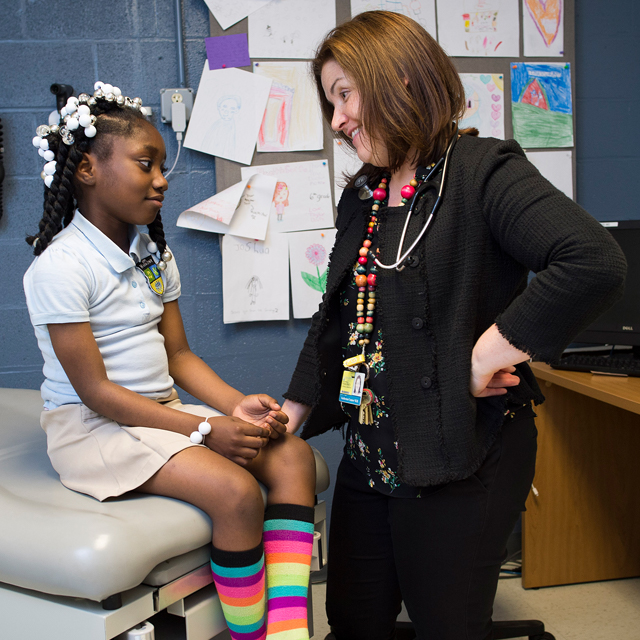Reaching Out, Building Community Ties

KIPPster Chloe Spencer with Rales Center Medical Director Kate Connor
The greater Baltimore area is home to tens of thousands of children in low-income communities. Too often, many families do not get adequate medical care or information that could help these children lead healthier, happier lives. While the reasons for this gap are myriad, ranging from language barriers to simple lack of opportunities or access, the consequences are clear. Poverty has been associated with poorer health, greater school absenteeism and lower educational attainment.
Against that backdrop, Johns Hopkins Children’s Center has joined forces with private donors to launch outreach programs designed to build ties to these underserved communities.
“Addressing socioeconomic or racial/ethnic health disparities in our community is one of the most important missions of the Children’s Center,” says Tina Cheng, pediatrician-in-chief and co-director of the Children’s Center.
In 2014, Cheng helped launch The Rales Center for the Integration of Health and Education, which works to reimagine school health programs to improve the health and educational outcomes of students in low-income communities. Funded by philanthropy—largely by The Norman R. Rales and Ruth Rales Foundation—its vision is that good health leads to academic achievement and lifelong successes.
The Rales Center established a school-based health clinic at KIPP Baltimore—which boasts more than 1,500 students at two schools—staffed by a doctor, a nurse practitioner, nurses, a medical assistant and a family advocate, explains Sara Johnson, a population health expert who helps design programs at KIPP, which stands for Knowledge Is Power Program. But it’s more than a clinic. The program partners with KIPP Baltimore to provide everything from health education, vision screening and optometry, and social and emotional learning programs in classrooms.
“We hope that the program at KIPP can be a model for other programs in Baltimore and beyond,” Johnson says. “We’re trying lots of things to see what works best.”
One particular focus has been on asthma, which is a leading cause of absenteeism. The Rales team does checkups, administers medicine and offers guidance on managing the disease. The results? Reduced absenteeism and emergency room visits.
“It’s really a wellness program,” Johnson says. “We treat the whole child, so they can do their best in school.”
Meanwhile, in another part of town, Sarah Polk, assistant professor of pediatrics, runs the Center for Salud/Health (Centro SOL), a multidisciplinary health center specifically for the Latino community.
Like the KIPP program, Centro SOL is more than a medical clinic, offering programs like a summer camp and free workout classes every Saturday to improve physical fitness. There’s even a summer internship program for bilingual high school students to introduce them to career opportunities in the medical profession.
Clinical care is important, but clinicians are limited in how much they can accomplish from the exam room alone, Polk says. It is this multifaceted approach of Centro SOL’s programs that sets it apart and has helped make in-roads in an otherwise underserved community—programs that would not be possible without integral support from donors like the Aaron and Lillie Straus Foundation and Leonard and Helen R. Stulman Charitable Foundation.
“We are grateful for the support of these foundations that allows us to address the needs of underserved children, adolescents and families in our community,” Cheng says. “I am proud of the Rales Center and Centro SOL, which develop and evaluate innovative models of care to make sure that children thrive.”